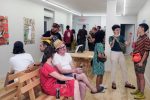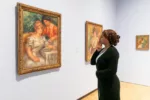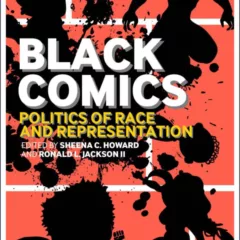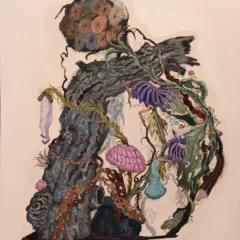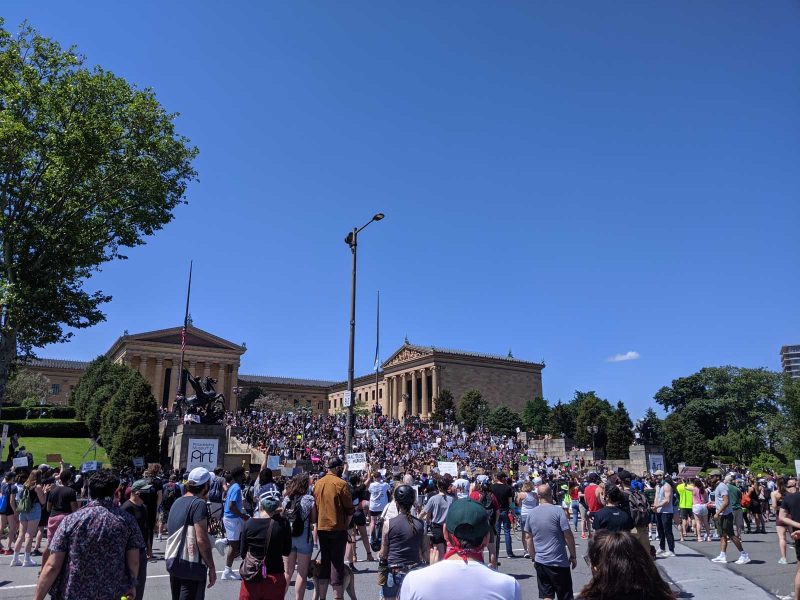
Land Acknowledgement statement: This article was written in Philadelphia, which sits on part of the traditional territory of the Lenni-Lenape, called “Lenapehoking.” I acknowledge the Lenni-Lenape as the original people of this land and their continuing relationship with their territory. And I affirm the aspiration of the great Lenape Chief Tamanend, that there be harmony between the indigenous people of this land and the descendants of the immigrants to this land, “as long as the rivers and creeks flow, and the sun, moon, and stars shine.” (shortened from the land acknowledgement statement on the tribal website)
Author’s Preface: “I was angry at museums” declared the renowned African American artist Fred Wilson during a conversation at the Ratcliff Institute last month, related to his groundbreaking exhibition, “Mining the Museum,” at the Maryland Historical Society, now called the Maryland Center for History and Culture, in 1992. Wilson was referring to the representation and narrative of Black people in museums in the 1990s. I shared Wilson’s feeling during a couple of recent visits to the Philadelphia Museum of Art (PMA) when I went to gauge the museum’s efforts to highlight African American art during this time of racial reckoning. This sentiment vanished during recent interactions with the Barnes Foundation and the Pennsylvania Academy of the Fine Arts (PAFA). Both institutions offered programming which substantially addressed race and difference. More on this below.
PMA Navigational Tool
Back in early February, fellow Artblog contributor, Andrea Kirsh, reviewed the new navigation guide created by the PMA to help visitors identify works of art by African Americans in the collection. In addition to the free leaflet available at the museum information desks, the PMA has also brought a few works back from storage by contemporary African Americans artists that hadn’t been exhibited in quite some time.
I was ecstatic to see “Dakar I” (1969), Sam Gilliam’s colorful and lyrical Drape painting or “Hydrangeas Spring Song” (1976) by Alma Thomas, a dynamic composition on the variation of repetitive patterns.
The Sam Gilliam, in particular, reminded me of times when the PMA made bold and avant-garde curatorial decisions, such as when it hosted a site-specific installation titled Seahorses in 1975. The installation showcased monumental paintings by Gilliam draping the exterior plain walls of the East façade of the museum. This lyrical celebration of colors facing the city, by a Black artist and in the aftermath of the civil rights movement seemed inspirational. However, I wonder how clearly viewers were made aware of the painter’s race and ethnicity.
In light of the ongoing national reckoning, and the conversation on systemic racism and white supremacy that followed last year’s police killing of George Floyd, the PMA navigation guide initiative, as well intentioned as it might be, falls short.
As I wandered the museum galleries, navigation guide in hand, the powerful slogan Say their names heard at many protests against police brutality kept popping into my head. Works by major Black artists such Faith Ringgold, Elizabeth Catlett or Barbara Chase-Riboud, all in the museum collection, were nowhere to be found despite being featured in the ongoing online exhibition page of the museum titled “African American Art.” Martin Puryear was another notable absence.
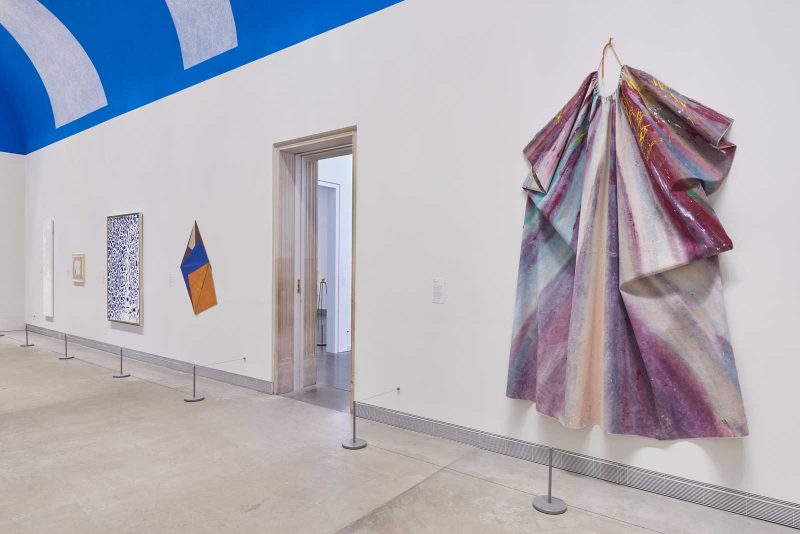
Upcoming PMA exhibition of Senga Nengudi
It has been a challenging time, to say the least, for museums and cultural institutions. The major renovation and extension campaigns underway at the PMA have certainly complicated matters. I hope that the new and expanded galleries set to reopen next month will present a more comprehensive view of African American art, and a narrative compelling to a broader swath of visitors, one that could resonate with the more than 40 % Black residents of Philadelphia.
The Senga Nengudi exhibition opening next month at the PMA will be a welcome program. It will highlight a leading contemporary African American artist who for more than 50 years has been pushing the boundaries of abstract art by focusing on the Black female body and complex societal and cultural issues.
Barnes and PAFA
Despite the last twelve months of prolonged closings, postponed or cancelled exhibitions, which resulted for some museums in budget cuts, staff layoffs and limited resources, the Barnes Foundation and the Pennsylvania Academy of the Fine Arts (PAFA) found ways to rise to the occasion. The Barnes directly engaged with the community on the social and political impact of systemic racism and white supremacy while PAFA has focused on issues relating to art and African Americans.
Since the Fall, 2020, and every month since, the Barnes has been hosting a series of free livestream online conversations, Facing Change, focusing on racial equity and understanding the impact and consequences of racism.
You might argue that it is unfair to compare real physical art displays such as at the PMA with online talks, which might appear less involving or at least easier to program. But my point is to highlight, regardless of the medium, how museums have recently decided to address racial disparities.
For this online series, the Barnes has joined force with local organizations OneHunted, Small But Mighty Arts, and the Philadelphia Asian American Film Festival and Loraine Ballard Morrill.
Loraine Ballard Morril, one the greatest female radio voices of Philadelphia, is the moderator of these on-line conversations. She is the director of News and Community Affairs for iHeartMedia’s six Philadelphia stations, and the host and producer of two weekly local public affairs radio programs, “Insight” and “What’s going on.” Her breadth of knowledge, softhearted voice and demeanor, and smooth interviewing skills are essential to the success of this series.
Each discussion explores a different angle of racism. The first one was on “Anti-racism” followed by “Race as a Social Construct” then “Colorism.” The next one, scheduled for April 19, will focus on “The Myth of White Adjacency.”
Each conversation, broadcast live on the streaming platform Twitch, includes three speakers from diverse backgrounds: community organizers or activists, academics and artists, with the goal of fostering “a multicultural and intergenerational conversation about race in America.”
The events start with a formal presentation addressing the topic, followed by a discussion amongst the participants punctuated by questions from the moderator and the audience.
For anyone interested in learning about the pernicious effects of racism; broadening one’s understanding of its deep-seated roots; and finding ways to raise awareness and combat racial discrimination and prejudice, Facing Change is an accessible, valuable and effective source.
Upon hearing about the series, I initially cynically thought that it was going to be a self-serving exercise in complacency by a righteous institution. My assumption quickly vanished when I tuned in the first time and listened to an edifying overview of “Race as A Social Construct: Racial Otherness and Imagining the Foreign Threat” by local curator and lecturer Rob Buscher. I kept telling myself that everyone should be exposed at least once to the visual material selected and analyzed by the presenter in order to fully understand how racial visual stereotypes towards Native, Asian and Black people took root, grew and persisted.
The quality of the forum was driven home when I retroactively watched the very first discussion, which I had missed. The keynote presentation on Colorism, the theme of the discussion by Dr. Yaba Blay, one of the leading scholarly voices and an activist on Black women and girls’ identity politics, was equally revealing and disheartening. Luckily, recordings of past programs are posted on the Barnes’ YouTube channel.
As the host, the Barnes could have easily patted itself on the back by focusing on the foundation’s recent efforts on racial equity and representation. But it is worth noting how little reference, if any, is made on the subject. That said, it doesn’t absolve the Barnes, or any other cultural institution, from having to examine its past racial biases.
The Barnes’ series might be unique in providing space to discuss one of the most pressing, enduring and shameful social and political issues of our history, without dwelling solely on its impact on the art world.
Speaking of which, PAFA has joined in the effort with focused programming on how things have been unfolding in the arts. PAFA’s popular and free “Art at Noon” series also produced remarkable thought-provoking talks specifically related to racial minorities. Past “Art at Noon” can be viewed on the PAFA YouTube channel.
The conversation on contemporary monuments and public art from late January between TK Smith, curator, writer and Ph.D. candidate at the University of Delaware, in conversation and PAFA Twentieth Century Art Curator, Dr Brittany Webb, expertly framed the challenges related to the perception and reception of monumental art by Black artists in the public space.
A previous “Art at Noon” discussion from early December between Bakirathi Mani, professor of English Literature at Swarthmore College, artist Annu Palakunnathu Matthew and contemporary curator Jodi Throckmorton examined the workings of racial identity in the South Asian American community through ethnographic and contemporary photography.
These important discussions along with inclusive and forward-thinking curatorial practices might help some of us to feel less angry at museums. Fred Wilson’s feelings were related to the way Black people were represented, misrepresented or obliterated in museums or historical sites already thirty years ago.
Wilson was given carte blanche by the Maryland Historical Society to reinterpret the institution’s collection, or rather to correctly interpret its historical artifacts in the context of their production, primarily during the 18th and 19th centuries. Wilson brought back from storage numerous artifacts, overlooked and rarely seen.
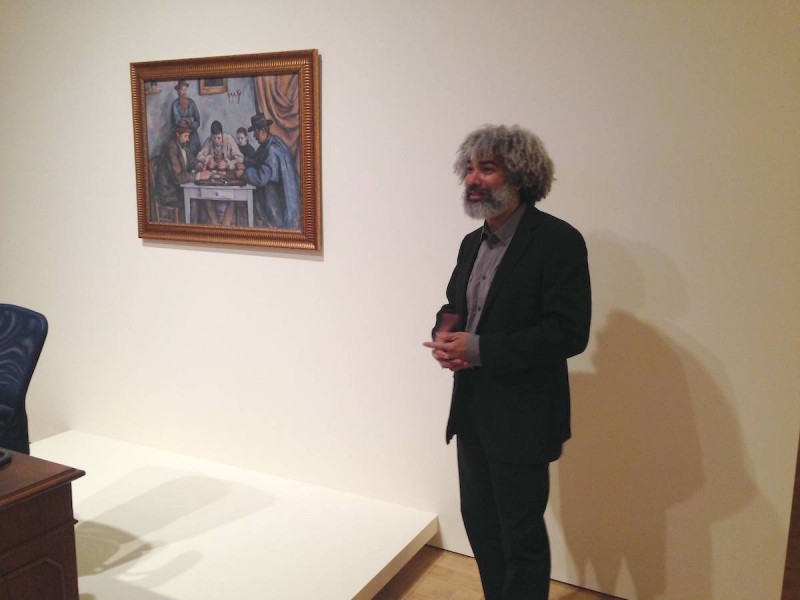
In 2015, Wilson repeated a similar mode of operation for a group exhibition commissioned of three artists by the Barnes. The impetus of the “The Order of Things” was to reflect on the unique and the singular arrangement Dr Barnes created to display its collection, and more generally on museography as a discipline. Wilson created ensembles with artifacts and works of arts not visible to the public at the Barnes. Although Wilson’s work at the Barnes didn’t have the political and social dimension and impact it had at the Maryland Center for History and Culture, it raised important questions about the process of deciding what should be exhibited, how the visible is contextually framed and ultimately what remains invisible. In a review of the Barnes show for Artblog, Roberta Fallon writes “Walking through Wilson’s piece, which takes some time and allows you to ponder, offers epiphany-ready ensembles that focus the mind on the worker bees of the Barnes, those who dust, answer the phone, stack up the benches in storage and deal with the moveable coat racks.”
One emblematic display case in Wilson’s Maryland Center for History and Culture installation titled “Metalwork 1793-1880,” has become an art history textbook favorite for the way it encapsulated the issues at stake. Several sterling silver repoussé tableware pieces, including a pitcher, a jug, and cups were harmoniously presented in a glass display case. It is only when approaching the display case more closely that the viewer notices that the artifacts create a frame of sorts to a set of Black slave shackles.
The questioning provoked by this arresting juxtaposition, constantly at play throughout the exhibition, centers around curatorial biases and the decades, if not centuries, of Western museums’ deliberate obliteration of minority cultures and histories.
“Metalwork 1793-1880” repositioned the production of tableware within the context of the American slave economy, from which we have yet to emerge. An argument can be made that racism, brutality (be it at the hands of slave owners in the past or the police today) and economic inequality faced by African Americans have hardly changed and represent the biggest failure of our democracy.
Mining the museum opened a week after the acquittal of the four white police officers accused of brutally beating Rodney King and the so-called Los Angeles Riots that followed. Today, it truly feels that the lessons of Wilson’s groundbreaking exhibition have hardly been absorbed.
Next Barnes ‘Facing Change’ discussion, on the topic of cultural appropriation – June 14, 2021
Art at Noon Pennsylvania Academy of the Fine Arts
‘Senga Negudu: Topologies,’ Philadelphia Museum of Art, May 2 – July 25, 2021


